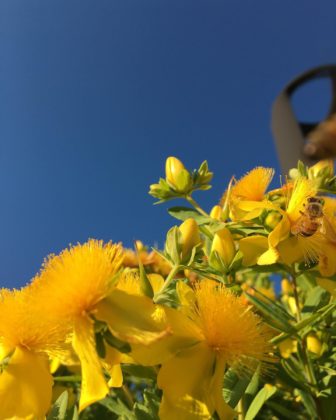CULLOWHEE, N.C. – As heat waves continue to batter countries throughout the Northern Hemisphere this summer season, it is a real-time reminder of the ramifications of a globally-changing climate system that is warming. Record heat waves, fires, and extreme weather continue to increase in force and range throughout the world so it is important to remember that even small actions can make a difference when the focus is turned toward healing the earth.
A tool many farmers and gardeners use to support healing the earth is the use of cover crops, plants that are sown and plowed to improve soil health. The Sustainable Agriculture Research and Education program that focuses its attention on the midwest and upper Great Plains notes that cover crops offer numerous benefits including slowing erosion, improving soil health, enhancing water availability, smothering weeds, helping control pests, and diseases, and overall increasing local biodiversity. Cover crops also break up hardpan, fix nitrogen into the soil, and can capture carbon dioxide.
Pagan Connection
Our interest in cover crops was grabbed by St. John’s wort (Hypericum Perforatum), a plant well-known to many Witches and Pagans. While an invasive species in some areas and dangerous to livestock, the disadvantages can be navigated by conscientious farming practices.
Dr. Debra Burris is a third-generation cattle farmer, master naturalist, professor of Physics at a central Arkansas State University, and fellow Pagan. She has often navigated the farming world using not only scientific practices, such as indigenous plant use but also by incorporating spirituality into her farming practices, as well by paying her respects to the genius loci (protective spirits) of her land and Epona, the great protector of horses.

Dr. Debra Burris – courtesy
As Dr. Burris considers herself a “steward of the land,” and incorporates methods of cover planting that are beneficial to her livestock as well as the earth. She recommends using native plants and grasses that can be found in your area when farming while also educating yourself on what could be potentially harmful to wildlife.
According to Burris, using native plants such as turnips and clover (the latter indigenous to her area in Arkansas) can not only benefit the local wildlife such as deer and songbirds indigenous to each specific area but can also be great pollinators for bees.
“Anything we can do to keep native plants healthy and anything we can do in our own little area can make a difference; any little bit helps.”
Cover Crops
The use of “Cover Crops,” those crops planted in between yield crops as a form of soil and crop management, has been a practice in the agricultural world for centuries, specifically the practice originated via terrace gardening in Asia.

St. John’s wort (hypericum) is a pollinator plant and is used occasionally as a ground cover – Image credit: E. Thornton
The term “Cover Crop” or ground cover, was adapted in the 1950s as agriculturalists began to study the use of this method in producing more efficient and precise crops for the ever-expanding population.
As the advantages of cover crops have widely been known in the agricultural world for decades, it is only over the past decade with the emerging evidence of climate change that scientists have begun to study the contributions of cover crops.
Alongside regular crop rotation and environmentally conscientious farming practices, cover crops have been shown to mitigate climate change as well as help the soil and nutrients adapt to more extreme variants in temperature change.
Cover Crops and Carbon Sequestration
In February of 2021, the U.S. Department of Agriculture released a study on cover crops and their growing use and advantages of them in the US. Among these advantages listed, one of the most important is the public health benefits which pertain to less runoff of sediments and nutrients into waterways, reduced flooding in watersheds, and greater soil carbon sequestering.

A corn field being cleared for planting in Cullowhee, N.C. – Image credit: E. Thornton
Soil carbon sequestering, also known as regenerative agriculture is the process of using photosynthesis to “draw down” excess carbon in the air to remain in the soil, therefore reducing the amount of carbon and heat-causing gases in the air. Studies have shown this process, alongside proper land management techniques, to be effective in the reduction of carbon, and some claim this could lead to reducing the detrimental effects on global warming.
On The Ground
The Wild Hunt reached out to Susan Nolter, a farmer with over 20 years of experience and owner of Blazing Star Flowers, located outside of Asheville, North Carolina for a personal and professional perspective on the use of cover crops as a practice.
While she does not identify as Pagan, Nolter has a great love of farming and taking care of the earth. She encourages the use of cover crops for their abilities to “sequester carbon, suppress weeds, prevent erosion and add nitrogen to the soil,” also states that planning needs to be a major part of using them and can also be time-consuming for the everyday farmer.

Susan Nolter, owner of Blazing Star Flowers. Image credit: Susan Nolter
“It’s a lot of work and there needs to be a lot of planning, not only for which cover crop to plant, but also allowing time for cleanup in between your yielding crops.”
Nolter recommends using crops that can be easier for cleanups such as oats and peas, or crops that are hearty such as Winter Rye, that can be planted a bit later to allow more time to harvest the yield crops.
She also suggests using pollinator crops for butterflies and bees as they are also essential in maintaining a healthy ecosystem.
Additionally, Nolter recommends learning your “windows” in between crops and allowing a break in between for maximum benefits of land management and soil protection.
A recommendation from the US Department of Agriculture for farmers is to use cover crops as intermediate cash crops. Crops such as oats, legumes, ryes, and kinds of wheat can help maintain the added benefits of soil management and sequestering but also help take off some of the financial burdens on farmers.
The Department of Agriculture also offers financial incentives for farmers to use cover crops and crop rotation in practice with many grants and educational assistance through the federal government.
Overall, Nolter does encourage the use of cover crops for farmers and though it is more planning and work, Nolter said, “Using this method allows you a part in the bigger picture, as you can help reduce the amount of carbon in the atmosphere.”
As the world continues to find, old, new, and inventive solutions to climate change and its repercussions of it, the earth has given us one possible solution. The long-standing positive effects of these intermediate crops may just have more of an impact fighting climate change than we have realized and as it usually does, the earth has us covered.
The Wild Hunt is not responsible for links to external content.
To join a conversation on this post:
Visit our The Wild Hunt subreddit! Point your favorite browser to https://www.reddit.com/r/The_Wild_Hunt_News/, then click “JOIN”. Make sure to click the bell, too, to be notified of new articles posted to our subreddit.